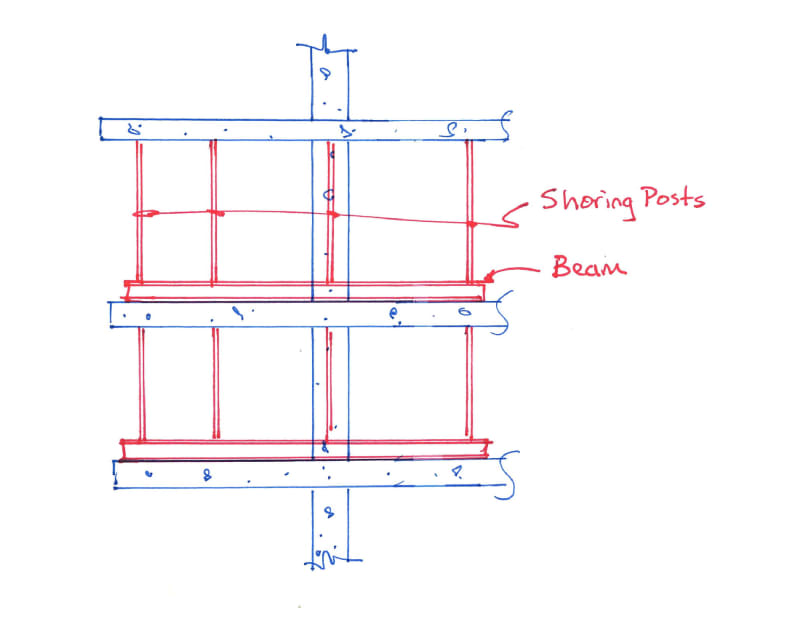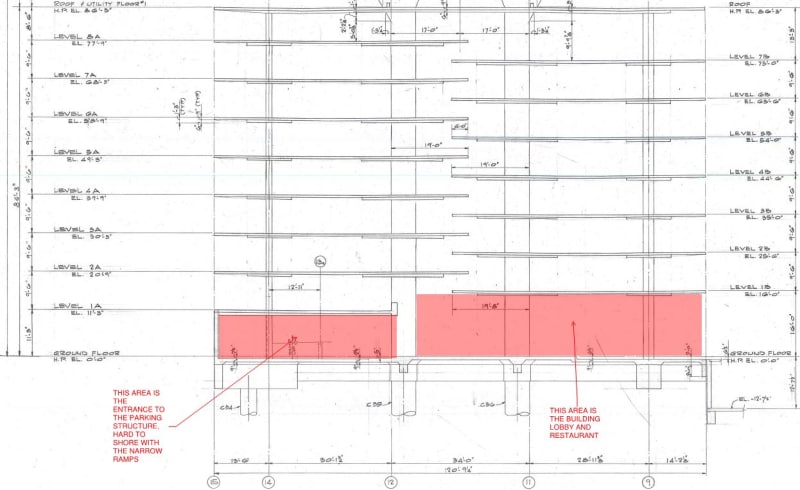DeeMIA
Structural
- Sep 19, 2018
- 5
Hello,
Looking for some out of the box ideas for this unique situation.
I am working on restoring the slab of a concrete framed parking facility of a high-rise residential building. It is a two-way slab with three bays in one direction, and 10 bays in the other direction. In the direction of the 3-bays, the two end bays are cantilevered. I encountered significant concrete delaminations along the column strips, top of slab, nearby the columns where the top steel should be developing. This situation occurs at various column strips throughout the structure, and also occurs at the same location on multiple levels. The parking facility is 9 levels. My worry is that during construction, the vibration for the chipping hammers will loosen up any bond that is left in the bars enough that it may cause a potential failure.
The ground level of the structure is a restaurant and a lobby space so shoring down to the slab on grade is not feasible. Traditional shoring down two levels to share the dead/live load of a particular level with other levels below is also not feasible everywhere as there are stretches that have delaminated concrete at a particular column strip at several levels below.
I have been contemplating a few options, the options I've thought about include:
1) Developing a triangular bracing frame to support the cantilevered slab and anchoring the frame to the column (could be costly if this has to be done at dozens of locations).
2) "Tying" all cantilevered slabs with post-tensioned cable so that they all react together. I am unsure about this one because although the slabs currently holds up to the service level dead and live loads, how can I prove that they will all act in unison to resist a slab that is trying to collapse if I don't know how much capacity I have left?
3) On a particular level (lowest preferred), drill through the column in the direction of the cantilever span, install reinforcement through the column and out to the cantilever, and cast a concrete wall. This would essentially create a very deep beam and transfer the loads to the column. The levels above the wall could then be shored traditionally.
I would like to hear if any of you have encountered this problem and how you resolved it. Or if you haven't encountered it, but you have some thoughts, that would be great as well. Thank you!
Looking for some out of the box ideas for this unique situation.
I am working on restoring the slab of a concrete framed parking facility of a high-rise residential building. It is a two-way slab with three bays in one direction, and 10 bays in the other direction. In the direction of the 3-bays, the two end bays are cantilevered. I encountered significant concrete delaminations along the column strips, top of slab, nearby the columns where the top steel should be developing. This situation occurs at various column strips throughout the structure, and also occurs at the same location on multiple levels. The parking facility is 9 levels. My worry is that during construction, the vibration for the chipping hammers will loosen up any bond that is left in the bars enough that it may cause a potential failure.
The ground level of the structure is a restaurant and a lobby space so shoring down to the slab on grade is not feasible. Traditional shoring down two levels to share the dead/live load of a particular level with other levels below is also not feasible everywhere as there are stretches that have delaminated concrete at a particular column strip at several levels below.
I have been contemplating a few options, the options I've thought about include:
1) Developing a triangular bracing frame to support the cantilevered slab and anchoring the frame to the column (could be costly if this has to be done at dozens of locations).
2) "Tying" all cantilevered slabs with post-tensioned cable so that they all react together. I am unsure about this one because although the slabs currently holds up to the service level dead and live loads, how can I prove that they will all act in unison to resist a slab that is trying to collapse if I don't know how much capacity I have left?
3) On a particular level (lowest preferred), drill through the column in the direction of the cantilever span, install reinforcement through the column and out to the cantilever, and cast a concrete wall. This would essentially create a very deep beam and transfer the loads to the column. The levels above the wall could then be shored traditionally.
I would like to hear if any of you have encountered this problem and how you resolved it. Or if you haven't encountered it, but you have some thoughts, that would be great as well. Thank you!

![[idea] [idea] [idea]](/data/assets/smilies/idea.gif)
![[r2d2] [r2d2] [r2d2]](/data/assets/smilies/r2d2.gif)


